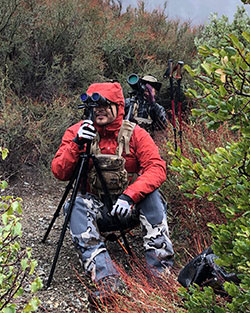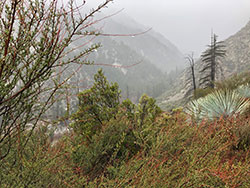On March 1, 2020, about 160 volunteers gathered near the rugged terrain for the annual sheep count. Their goal was to use spotting scopes and binoculars to locate sheep, and determine and record their gender and approximate age.
Some of the 160 people who assisted Fish and Wildlife with it's March 1 desert bighorn sheep survey. CDFW photo.

Charles and Nicole Lozano of Chino Hills using binoculars and a spotting scope to locate sheep. CDFW photo.

The San Gabriel Mountains, north of Ontario, where the sheep survey took place. CDFW photo.
The San Gabriel Mountains, north of Ontario, are a spectacular location for those who enjoy steep hikes and beautiful scenery. But one Sunday each year, those mountains are visited by people with a more specific agenda. They’re there to assist environmental scientists from the California Department of Fish and Wildlife in determining the number of desert bighorn sheep living there.
On March 1, 2020, about 160 volunteers gathered near the rugged terrain for the annual sheep count. Their goal was to use spotting scopes and binoculars to locate sheep, and determine and record their gender and approximate age. The volunteers attended a mandatory training session the night before in which CDFW staff briefed them on the purpose, counting techniques and best gear and supplies to bring for what can be a long day in tough elements. And as it turned out, March 1 was the one day in a stretch of about 20 that included a forecast of rain, and the forecasters nailed it. Between the fluctuating poor conditions – including a steady rain, low clouds, strong winds and even hail – nearly every volunteer struck out on being able to locate any sheep.
Fortunately, the annual count also includes an aerial survey the day before the boots-on-the-ground effort, and the weather was cooperative on Feb. 29. Eight CDFW employees took turns that Saturday flying in a Bell 407 helicopter over the locations where they’d likely find the sheep groups. Flights were limited to 2.5 hours before refueling was necessary. The crew of three on each flight was responsible for taking notes and guiding the pilot, using a handheld GPS to drop a waypoint at each observed sheep location, and capturing the animals with camera gear. The doors of the aircraft were removed to improve visibility for the spotters.
CDFW Senior Wildlife Biologist and survey coordinator Jeff Villepique said a key element of the effort is determining the health of the younger animals.
“One of the things we look at is how many lambs from last year have survived to this year,” said Villepique. “We did get some decent numbers that will help us determine the recruitment ratio and give an indication that the population is growing and doing well.”
When CDFW first started conducting these counts in 1979, the desert bighorn sheep in the San Gabriels numbered about 740. That dropped to fewer than 200 in the late ‘90s, and currently the population is back up to about 400. Villepique said the numbers rise and fall based on food availability, habitat loss, weather patterns and the history of wildfires.
One group that enthusiastically supports the survey is the Society for the Conservation of Bighorn Sheep. Volunteer Debbie Miller Marschke has joined the effort multiple times, and despite the lousy weather conditions, was happy to be out in the mountains once again.
“When you get out in the environment and you’re with positive people, it’s not a wasted day, it’s a memorable day,” Miller Marschke said, smiling as she braved the downpour. “If I stayed home, I wouldn’t remember what I did a month later. I’m going to remember this day all year long.”